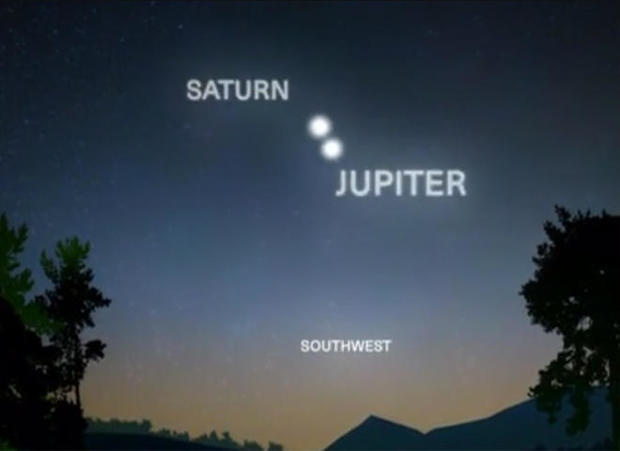Jupiter and Saturn will overlap in the sky tonight: “Aligned just right”
Jupiter and Saturn #JupiterandSaturn

Astronomer Christopher De Pree is about to see something unseen from Earth since Galileo first pointed his telescope at the stars. Our solar system’s two biggest planets in one viewfinder: Jupiter and Saturn.
All month, just after sunset, skywatchers have captured the pair of planets slowly coming together in the southwest sky.
Monday night, they’ll overlap — appearing to merge into a single source of light. It’s called an astronomical conjunction.
In metro Atlanta, De Pree directs the Bradley Observatory at Agnes Scott College. He told CBS News’ Mark Strassmann how close Saturn and Jupiter will actually be to each other.
 This evening the planets Jupiter and Saturn will appear to merge. CBS News
This evening the planets Jupiter and Saturn will appear to merge. CBS News
“Oh they’re hundreds of millions of miles apart,” De Pree said.
“A bit of a cosmic trick of the eye,” Strassmann responded.
“Yeah, exactly. Just like constellations are,” De Pree said. “It’s like a big machine that’s just running forward. And on the 21st is when all those pieces are aligned just right for these two planets to get really, really close.”
That big machine is our solar system, constantly in motion. Every 20 years Jupiter laps Saturn, and both planets line up with Earth.
“It is true that these two planets did come close actually 20 years ago,” De Pree said. “But you couldn’t see them up in the sky. They were too close to the sun. The big difference here is that you can actually see them after dark and that’s what’s unusual about it.”
The last visible conjunction this close was in 1226 – nearly 800 years ago.
Monday night’s conjunction falls on the winter solstice, like a “Star of Bethlehem for Christmas week 2020.”
“Since the whole solar system is this kind of clockwork, you can wind the clock back for thousands of years and you can see where planets would have been at the time in the past,” De Pree said. “Kepler is one of the astronomers who actually hypothesized that the ‘Star of Bethlehem’ could have been a planetary conjunction.”
“Given how rare this moment is, how maddening is it going to be if it’s overcast?” Strassmann asked.
“Well, as an astronomer, I’m used to that,” De Pree said. “You know, if you can go out the night before or the night after, it’ll still be an impressive sight.”
And it won’t happen again for 60 years.
“I mean, to me, some of the most wonderful experiences that you can do viewing the night sky are the ones that require nothing,” De Pree said. “They don’t require a telescope. They don’t require binoculars. It’s just you looking at the night sky.”
All you need is your stargazing curiosity.
© 2020 CBS Interactive Inc. All Rights Reserved.